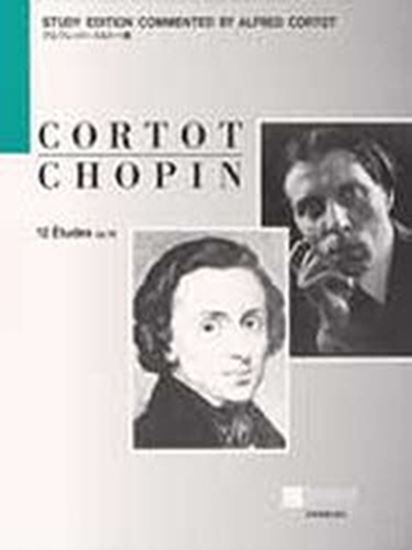Chopin, Frederic : 12 études Etude No.12 c-moll Op.10-12
Work Overview
Genre:etude
Total Playing Time:3 min 00 sec
Copyright:Public Domain
Commentary (2)
Author : Imazeki, Shiori
Last Updated: August 7, 2019
[Open]
Author : Imazeki, Shiori
The autograph manuscript is housed at the Stiftelsen Musikkulturens Främjande (Foundation for the Promotion of Musical Culture) in Stockholm.
Composed between 1830 and 1832.
C minor, 4/4 time, Allegro con fuoco
It is known by the common name "Revolutionary," given by Franz Liszt. It is said that Chopin, upon learning of the Russian army's invasion of Warsaw in December 1830, was driven by despair and anger to compose this work the following year. However, it is actually believed that he had begun working on it prior to 1831.
The challenges include the right-hand octave melody and the intricate left-hand sixteenth-note passagework. It requires independence of the left-hand fingers, effortless extension of the right hand, and the ability to play chords including octaves smoothly, with each note evenly articulated.
It begins with a sense of tension in a C minor dominant seventh chord, and the piece continues without the tonic chord being sounded until measure 10. The right-hand octave theme (from measure 10) is presented resolutely amidst the urgent atmosphere of the left hand's undulating figuration, moving from low to high registers. After a highly modulatory middle section, the sixteenth-note unison passage for both hands, first appearing in measure 5, is recapitulated (from measure 44), and the opening theme returns (from measure 50). In the coda from measure 76, the parallel major, C major, temporarily appears, creating a momentary sense of calm. However, the piece concludes with a rapid descent in both hands, in unison, from the high to the low register, bringing it to a close.
Author : Ooi, Kazurou
Last Updated: March 12, 2018
[Open]
Author : Ooi, Kazurou
No. 12 in C minor, "Revolutionary" There are no particularly noteworthy points regarding overall musical understanding. However, when many ornamental notes enter the right hand, the left hand's 16th notes are arranged without pause. It is crucial to prioritize the right hand while ensuring the music does not stop. This etude, in particular, has a wide variety of performance approaches, differing considerably among performers. There is no single right or wrong way. Please use what will be discussed as an example.
Regarding Pedaling
First, regarding the opening, you can assume that the pedaling issue continues until measure 8. This means that many learners tend to overuse the pedal, causing muddiness in the 16th notes. For these initial 8 measures, keep pedaling to a minimum, exercise restraint, and avoid muddiness in the 16th notes. The subjective issue of whether something is muddy or not can lead to very delicate examples when performing Romantic pieces. Basically, prioritize the bass. For example, in measure 9, the pedal should be sustained for the entire measure without any change. In this case, the bass is the initial C in the left hand, and there are no lower notes within this measure.
Therefore, you continue to sustain the C bass. However, if you were to change the pedal midway, for instance, on the third beat, you would instantly lose the bass.
In measure 10, the bass appears at the beginning of both the first and third beats. In such cases, I believe it is acceptable to change the pedal on the third beat. Especially in cases like measure 12, where the melodic line forms a minor second, changing the pedal on the third beat is essential. In measure 15, for example, the chords change every two beats, so of course, you change the pedal each time.
In measure 17, even though the bass is written only on the downbeat of the first beat, if the subsequent progression is chromatic, it is left to the performer's discretion. However, the author would likely sustain the bass for two beats and then use the pedal sparingly. In sections like measure 29, there is only one bass note, so this note is sustained with the pedal to some extent, but for beats 3-4, it might be changed finely, or the pedal might not be necessary.
Furthermore, in cases like measure 36, where a crescendo leads to fortissimo, even if the left hand's 16th notes follow a scale, apply sufficient pedal to create a rich sound. Generally, be careful not to overuse the pedal.
Regarding Dotted Rhythms
This piece is characterized by dotted rhythms throughout. The musical character changes dramatically depending on how these are performed. Please make sure to master what will be discussed.
Let's take the notes from the fourth beat of measure 2 to the first beat of measure 3 as an example. Please apply this reference to all dotted rhythms. Assume there are three notes from the fourth beat of measure 2 to the first beat of measure 3.
Of course, this means there are three notes when viewed vertically: A-flat, G, and D. A-flat is dotted, G is a 16th note, and D is a half note. Although an accent is written on A-flat, the force should be applied to this note and to the D in measure 3. These two notes receive the emphasis. Therefore, the G in measure 2 should be played without force, treated as an ornamental note attached to the D, and the two notes should be played "in one swift motion" and "at once."
This means that G and D will be played almost simultaneously. Moreover, if there is almost no force on G, the dotted rhythm will sound smooth. This is essentially all there is to it, but it becomes quite tricky later on. Since G to D is a fifth apart, not many people struggle with this. However, for example, the same rhythm from the fourth beat of measure 4 to the first beat of measure 5 is a seventh apart. Learners then tend to either put too much force on G, or the timing from G to the next F becomes extremely delayed, or both. The reason it might work the first time but not the second is clearly due to the wider reach. When jumping a seventh, fear of mis-hitting inevitably leads to such phenomena.
In this case, sectional practice should focus only on the two notes, G to F. After playing G in octaves, quickly move your hand to F. However, do not play F; simply place your finger on the key. Repeat this several times. When placing your finger on F, does your hand search for it, or does it land precisely? Or does it land on a different note? Repeat several times, and confirm that when you swiftly move your hand to the right, it lands perfectly on F. Once you can do this, with your finger on F, press the key down. Repeat this several times as well. By doing so, your hand will memorize the interval from G to F.
For good measure, it would be even better to practice the reverse version, descending from F to G. Once you can accurately hit from F to G without issue, then release the force on F and play the two notes "in one swift motion" and "at once." All subsequent dotted rhythms should be handled in this manner.
Musical Interpretation
In this piece, the C minor tonic chord first appears in measure 9. This is where C minor is strongly recognized, and it is also a very fateful place, so it should be played forte. Now, before reaching measure 9, in measures 7-8, there are two major seventh leaps in the 16th notes. In such cases, do not rush the leaps; take a little time. The dynamics are divided into three stages: measures 7 (beats 1-2), measures 7 (beats 3-4), and measure 8, respectively. Increase the dynamics as the music progresses, for example, mf, f, ff.
In measure 17, the E-sharp in the melodic line should ideally be E-flat, making it a very shocking chord. Try to express it accordingly.
From measure 50 onwards, many non-harmonic tones and ornamental notes enter the melodic line. Never play these sections strictly on time (according to the metronome); take ample time.
This piece is also one that is performed in many different ways in various recordings available. If the author were to offer personal advice to all of you, it would be to distance yourselves from the metronome as much as possible, use a lot of rubato, and take ample time. For example, the left-hand bass in measure 11 is when the right-hand melodic line reaches its peak. After playing the bass C, it would be good to take a little time before starting the next note, G. This serves not only the purpose of musically expressing the E-flat in the melodic line strongly but also the purpose of changing the pedal without muddiness.
Additionally, in places where Chopin did not write tuplets, for example, the first note of the left hand in measures 29-31 is not a tuplet. In such places, take ample time.
PTNA & Partner Channel Videos(12items) View More
Sheet MusicView More
Scores List (58)

(株)ドレミ楽譜出版社

(株)全音楽譜出版社

(株)春秋社

(株)全音楽譜出版社

(株)全音楽譜出版社

(株)全音楽譜出版社

(株)全音楽譜出版社

(株)全音楽譜出版社

(株)全音楽譜出版社

(株)ドレミ楽譜出版社

(株)音楽之友社

(株)ドレミ楽譜出版社

(株)ドレミ楽譜出版社

(株)学研プラス

(株)シンコーミュージックエンタテイメント

(株)リットーミュージック

(株)リットーミュージック

(株)全音楽譜出版社

(株)シンコーミュージックエンタテイメント

(株)全音楽譜出版社

ハンナ(ショパン)

(株)ヤマハミュージックエンタテインメントホールディングス

(株)シンコーミュージックエンタテイメント

ハンナ(ショパン)

ハンナ(ショパン)

(株)シンコーミュージックエンタテイメント

(株)シンコーミュージックエンタテイメント

KMP(ケイ・エム・ピー) ケイエムピー

ハンナ(ショパン)

(株)リットーミュージック

(株)ドレミ楽譜出版社

(株)共同音楽出版社

ハンナ(ショパン)

KMP(ケイ・エム・ピー) ケイエムピー

KMP(ケイ・エム・ピー) ケイエムピー

(株)シンコーミュージックエンタテイメント

デプロMP

(株)シンコーミュージックエンタテイメント

(株)ヤマハミュージックエンタテインメントホールディングス

(株)シンコーミュージックエンタテイメント

(株)音楽之友社

ジェスク音楽文化振興会

(株)全音楽譜出版社

ヘンレー

ヘンレー

ヘンレー

ジェスク音楽文化振興会

(株)全音楽譜出版社

ヘンレー

ポーランド音楽出版社

(株)ヤマハミュージックエンタテインメントホールディングス

ロケットミュージック

(株)音楽之友社

Musikverlag Doblinger

(株)ヤマハミュージックエンタテインメントホールディングス



















